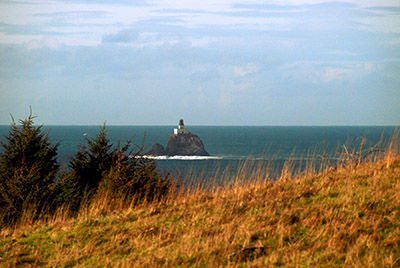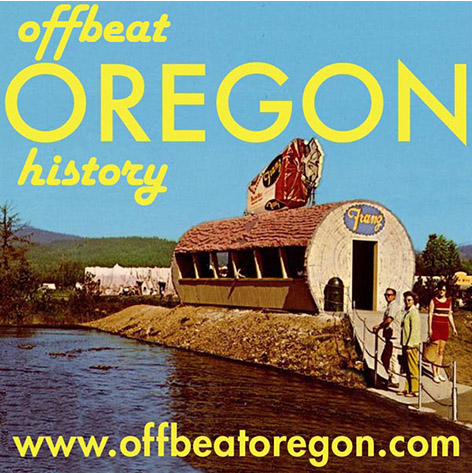TILLAMOOK ROCK, TILLAMOOK COUNTY; 1870s, 1880s:
Builders were hard to hire for scary lighthouse job
Audio version: Download MP3 or use controls below:
|

So the government allocated $50,000 for the job and started looking for a good place to put it. It quickly became clear that there really wasn’t one. Tillamook Head seemed a logical place, but it was 1,000 feet high; a light there would be invisible in heavy fog — exactly the weather condition in which a light was most needed. And then … there was The Rock. So Tillamook Rock was scouted by district lighthouse superintendent H.S. Wheeler — who managed, after many attempts, to get first himself and then, on a second attempt, his surveying instruments onto the rock in the summer of 1879. He was almost certainly the first human ever to set foot on the thing. The investigation proved that a lighthouse could be put on the rock. But it would require a great deal of dynamite to level off its top, and getting on and off the thing was a matter of deadly peril — as was soon demonstrated by the death of John Trewaves. Still, the only alternative was to accept the loss of dozens of lives and thousands of tons of shipping every year in preventable shipwrecks. That was unacceptable. And so the Lighthouse Board agreed to go ahead with it, and sent emissaries to San Francisco and other faraway ports in search of workers gullible enough to sign onto what the locals considered a suicide mission. Once there, the crew on the rock worked as quickly as they could, blasting and drilling and chipping out a level surface and laying the massive stone blocks — pinned together with heavy copper rods — of which the lighthouse was to be built. Supplies were at first landed via a cable stretched from the rock to the mast of the Thomas Corwin. This was also the workers’ only way on or off the island; they’d hang beneath the cable in a breeches buoy and, more often than not, get dunked in the sea at least once when a wave hit the ship. Later a crane was built, which picked supplies off the deck of the ship. It was a job to remember. The days were usually full of hard and tedious work, and the nights were occasionally full of terror and dread. For the entire winter of 1879-1880 the crew was camped out on that tiny chip of granite under siege by an angry sea, first in a tent and later in a rough wooden shack. That first winter, a hurricane carried off the storehouse, and it was several hungry, fretful weeks before the seas were calm enough for the Thomas Corwin to bring the men food. The following winter would be easier; a summer’s worth of construction had provided them with sturdy stone walls to hide behind when the massive hurricane-driven waves slammed themselves into the granite. It was still very hard to find workers willing to take jobs on the rock, though. There is a rumor that the services of Astoria’s shanghaiers were tapped to fill this need, and, although that seems unlikely, chances are pretty good that the supervisors dealt with sailors’ boardinghouse masters and other shady labor contractors whose men had no choice but to go. All through 1880 they worked, and by January of the following year the light was almost ready to shine. The workers were given added motivation to move as fast as humanly possible when, on Jan. 6, the 1,300-ton British ship Lupatia sank within sight of the rock, leaving a three-foot section of mainmast jutting out of the water as a silent reminder of just how much depended on their speed. (The only survivor was a dog.) Finally, on January 21, 1881, the wick of the great lantern was touched to flame for the first time, and the angry North Pacific was lighted for the first time with a powerful beam from the top of Tillamook Rock. The men had proven that it was possible to build a lighthouse on the least hospitable half-acre of land in the entire continent. Now the question was, could they keep it? We’ll talk about that challenge next week.
|
Background photo is a hand-tinted image of Tillamook Rock Light ("Terrible Tilly), published circa 1925 on a picture postcard.
Scroll sideways to move the article aside for a better view.
Looking for more?
On our Sortable Master Directory you can search by keywords, locations, or historical timeframes. Hover your mouse over the headlines to read the first few paragraphs (or a summary of the story) in a pop-up box.
... or ...

©2008-2016 by Finn J.D. John. Copyright assertion does not apply to assets that are in the public domain or are used by permission.

